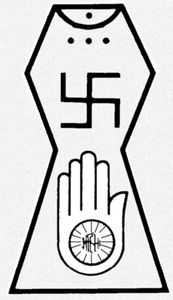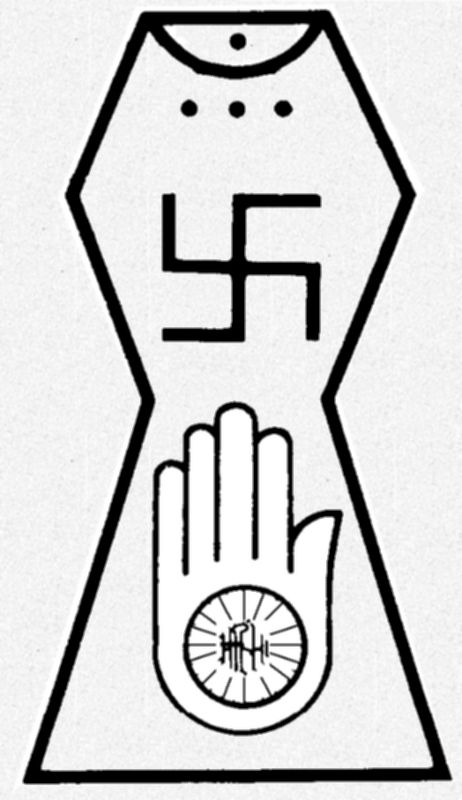According to the Jainas, their religion was revealed and transmitted by the Tirthankaras. The latter are sages who have attained perfection and for some of them enlightenment. The first Tirthankara is Rishabha. It was born before the emergence of the Indus civilization (ie 2500 BC) and is considered the traditional founder of Jainism. He is also quoted in the Vedas. Jainism would therefore be anterior to Hinduism.
Origins
23 other Tirthankaras succeeded him, not necessarily continuously. These are: Ajita, Sambhava, Abhinandana, Sumati, Padmaprabha, Supaardhva, Chandraprabha, Pushpadanta, Shitalnatha, Shreyaamsha, Vaasupujya, Vimala, Ananta, Dharma, Shanti, Kuntha, Aara, Mallinaatha, Munisuvrata, Nami, Nemi, Paarshvanath and Mahavira. Apart from the last two, there is no evidence of the historical existence of precedents.
Mahavira was born around 600 BC It is the last Tirthankara to date and is considered the founder of Jainism as it is still practiced today. He preached Jainism for 30 years before reaching enlightenment at the age of 72 years. Religion developed in northern India but in the 4th and 3rd century BC a famine forced the population to migrate to the south and northwest of India. The Jainas then separated into two branches. Some were called Digambars (very strict and not very open to changes) and the other Svetambars (more liberal). Today there are about 4 million Jainas in India.
Sacred texts
The 14 Purvas are sacred for all Jainas, whether Digambars or Svetambars. In the Purvas, the Svetambars add the 11 Angas (rules for ascetics), the 12 Upangas (Tirthankaras teachings), the 4 Mulasutras (basic laws), the 10 Prakirnakas (hymns), the 6 Chedasutras (discipline for ascetics) and the 2 Culikasutras. The Digambars add the Satkhandagama (description of karma), the Kasaayapahuda (discussion of the passions) and the Anuyogas.
beliefs
The Jainas consider the Universe as eternal, without beginning and without end. They differ in this from Hindus who believe in the creation and destruction of the Universe. The Jainas divide things into two categories:
- The living substance and provided with a soul (the jiva). It is found in men, animals, plants but also in the wind, fire ...
- the substance inanimate and devoid of a soul (ajiva). it is found in space, matter, time ...
The jiva is the sensitive energy that characterizes consciousness. There are two kinds: the released jiva (mukta) and the linked jiva (sansari). The released jivas have left the cycle of lives and deaths, they reside in the upper part of the Universe called Siddhashila. The connected jivas can be mobile (trasa jiva) or immobile (sthavar jiva), they are transmitted through the cycle of births and deaths. They are characterized by the number of senses they have (touch, hearing, taste, sight, smell). The motionless jivas have only one meaning and the movable jivas have a number of senses ranging from two to five according to their degree of knowledge.
For example, human beings and superior animals possess a mobile jiva provided with the five senses, the insects also have a mobile jiva but only two senses.
The ajiva characterizes all that has no soul. Things that possess ajiva have no birth, no death, no feelings, they are inert. The ajivas are divided into five categories: dharmastikay (movement); adharmastikay (rest); akashastikay (space); pugdalastikay (matter) and kal (time).
The jainas are very attached to the concept of karma. This one differs from the karma of the Hindus. The jainas regard karma as a substance, subtle and invisible. It is he who holds the jiva and causes the transmigration of souls. To liberate oneself from it is necessary several lives of discipline and penance. The liberation of the jiva, or moksha, is then attained. The Jainas consider that every action has its consequence and that it is impossible to escape from it. Thus every birth is conditioned by the actions of previous lives. The individual will then seek to improve his existence by eliminating evil deeds to free himself from karma. This is why the jainas advocate non-violence (ahimsa). They protect every form of life. Some jainas even wear a piece of cloth in front of the mouth to avoid swallowing insects. The ahimsa does not allow any incitement to violence, whether active or passive and it includes the principle of anekantavada, or relativity, which obliges the jainas to adopt different points of view and to always see the reality under different angles to eliminate preconceived ideas.
The jainas must follow three ideals: samyagdarsana (good belief), samyagjnana (good knowledge) and samyakcarita (good behavior). They are called the three jewels.
ritual
The Jainas do not worship any deity but pray to the sages and saints of their religion.
There are various forms of Jainas rituals. The most important is the pratikraman. It is practiced daily and aims to get rid and repent of sins in order to minimize the ties of karma. The pratikraman consists of six basic rituals: samayik, chauvisantho, vandana, pratikraman, kayotsagga and pratyankhyan. During the samayik, the faithful is in equanimity for 48 minutes. During this time he purifies himself from passions and desires by meditating and reciting mantras.
The aim of the chauvisantho is to worship 24 Tirthankaras in order to show them respect.
The vandana allows the faithful to show their respect to the monks in order to defeat the ego and the resentment. They serve as a model for them.
The prackraman during which the faithful ask for forgiveness for evil deeds. They seek to purify their souls and promise to improve in the future.
Kayotsarga is a form of meditation where the faithful concentrate on the nature of the soul and the body in order to better control mental and physical activities.

Symbol of Jainism
Pratyankhyan consists of a renunciation of certain activities in order to reduce the flow of karma. Its purpose is to prepare the faithful for total renunciation.
The sacred symbol of the jainas represents the palm of a hand in the middle of which is a chakra, then a swastika (symbol of the cycle of life) surmounted by three points (representing the three jewels) and a semicircle surrounding a point (representing the soul released in the upper part of the Universe.)
Important note: Let us point out here that the symbolism carried by svastika in the Jainas (or the Hindus) has nothing to do with that of the Nazis who merely took it back by defiling it and turning it away from its original meaning.
Celebration
Here are the 3 main celebrations that illustrated when you are a Jainist.
- Mahavira Jayanti: March April. This is the main Jaina festival. It celebrates the birthday of Mahavira, the 24th Tirthankara. The faithful are found in sacred sites such as Girnar and Palitana in Gujarat.
- Deep Diwali: October November. This celebration celebrates the liberation of Mahavira's soul from the cycle of life. The Jains read the sacred scriptures and illuminate their houses. The festival is of particular importance to Pawapuri in Bihar since it is there that Mahavira died at the age of 72 years.
- Paryushana: August September. It takes place for eight days with the Swetambars and for ten days with the Digambars. Paryushana marks the retreat of the monks due to the south-west monsoon which has prevented from moving around the country. During the feast the faithful forget the quarrels, ask for forgiveness and renew the bonds of friendship.
See also:




















